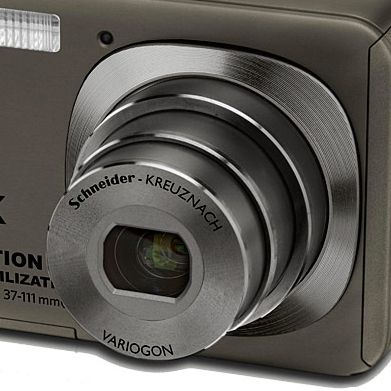The Kodak EasyShare V1273 looks very nice and sports some clever technology that includes the meat of its sibling, the V1253 and some new twists. This means you get Face detection AF, Perfect Touch technology and Smart Capture that, similar to Pentax’s auto shooting mode system, "recognises" the type of subject before it, sets an appropriate subject mode and lets you snap away.
Our quick take
Kodak’s EasyShare V1273 is a camera that’s more point and hope than point and shoot and the single most frustrating digital compact I’ve ever used. Grrrrr…

Kodak EasyShare V1273 digital camera - 2.5 / 5
| FOR | AGAINST |
|---|---|
|
|
The 12-megapixel sensor means you get large file sizes stored either on the internal 32MB memory or on external SD/SDHC cards, which slots into a port on the base of the camera alongside the rechargeable lithium-ion battery pack.
Here, however, we encounter the first problem with the V1273. The aforementioned port keeps slipping open, it does it while you’re carrying the camera in your hand, it does it if it’s in a pocket or safely snuggled into a camera bag and it’s simply a matter of time before it gets ripped off. Kodak: a sturdier catch or locking mechanism is a must.
The camera’s 37-111mm 3x optical zoom lens is a nice Schneider-Kreuznach Variogon optic that’s sharp and makes a good fist of getting detail on to that pixel-packed sensor, which means on the face of it, apart from the wayward battery/card port hatch, things are looking good.
But hold on a moment. According to Kodak, the V1273 "benefits" from having a touch-sensitive screen that brings your images and camera controls to "your finger tips". Well yes, it does. But the screen is an abomination, let me explain.
A low reflection screen, the V1273's screen has an odd milky appearance that at first worried me not a jot. In fact, the menu system is straightforward and uses some clever graphic elements including faded backgrounds to the menus that blend into the screen, using shaded gradients. Press a graphic element or icon on the milky screen and a menu pops out with a nice swooshing sound; sounds can be switched off in menus.
You are then presented with a contextual menu for the Smart shooting mode, though the controls, such as they are, are minimal as there are no manual controls barring exposure compensation in the only other setting (other than Smart mode): Program AE. You can control the flash modes but that's about it. The rest of the controls are buried within menus via a button alongside the LCD.
Mysteriously, while menus are easy to use, you cannot control the sensitivity or the white balance in use, which is rather limiting but befits its point and shoot ethos. Other, more usual options are there to play with, such as the control of resolution and switching the (rather good actually) optical IS on or off or changing the date and the auto power off settings.
But worryingly, you get limited control of the LCD brightness and this becomes a very major problem. There are actually just two brightness modes: power save and high power. Don’t bother with power save because even using the high power mode the LCD is almost impossible to view in daylight.
All the work done by Kodak’s boffins on the funky menus is wasted: you can’t see them properly in any lighting brighter than a moderately lit living room. Composing a shot is – almost – a waste of time and as there’s no optical viewfinder; framing is more or less pot luck.
Assessment of focus is therefore … impossible. Reviewing images on the camera … don’t bother. Changing shooting settings, bah! Why bother when you cannot see to change them anyway. I got angrier and angrier at this camera the more I used it.
I shot on a bright sunny day (surely, the most likely time anyone buying it would use it) and found it impossible to do anything more than throw my hands up in frustration. This is even more disappointing because all that squinting through the milky screen, shielding the camera under my shirt to give the screen some shade or my only being able to take pictures from the shady side of the street (just) actually netted some nice results.
Noise is well controlled at lower ISOs and detail isn’t bad either. Colours are vibrant and the Face AF worked well but not that I could see any of this until I got home and loaded the pictures onto my PC. Then it was a bit of a revelation and makes the murky uselessness of the touchscreen even more frustrating and disappointing.
If it were image quality alone, the V1273 would do okay as it’s a surprise, literally because you can’t tell at the time of shooting. But as the package is almost unusable because of the LCD, this is the second time I cannot do more than give a Kodak digital camera a low low score.
To recap
The Kodak EasyShare V1273 looks nice and feels robust, it has a nice lens and good Face AF with a clever touchscreen interface; it even takes nice photos. But it also makes me very, very, angry indeed. Read on to find out why…
